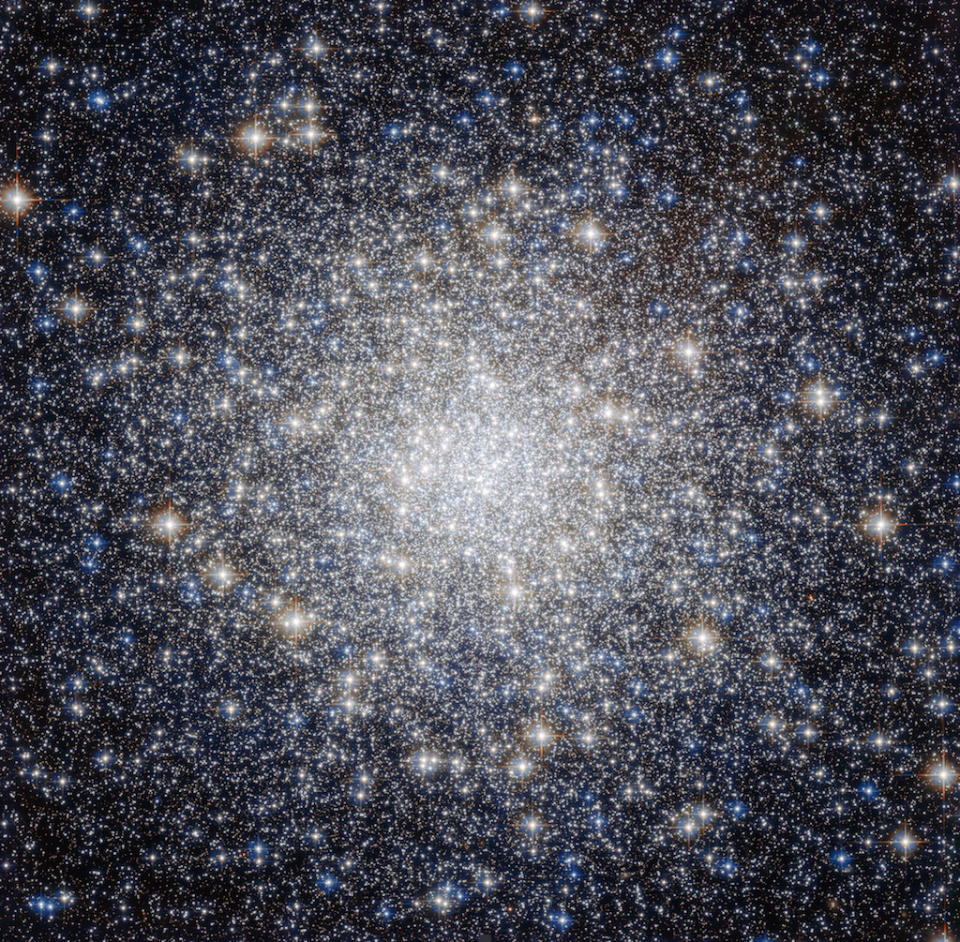Researchers have found that intermediate-mass black holes can form in dense star clusters containing anywhere from tens of thousands to millions of tightly packed stars called “globular clusters.”
One intermediate mass black hole it has a mass between 100 and 10,000 suns. They are heavier than solar-mass black holes, which have a mass range between 10 and 100 solar masses, but lighter than supermassive black holesthat have masses equivalent to millions or even billion of suns.
These cosmic intermediaries have proven difficult for astronomers to discover, with the first example being found in 2012. Designated GCIRS 13EIt has a mass 1,300 times that of the Sun and is located 26,000 light years away, towards the galactic center of the Milky Way.
One of the mysteries surrounding intermediate-mass black holes concerns their formation. Stellar-mass black holes are born when massive stars collapse and supermassive black holes grow from subsequent mergers of increasingly larger black holes. However, a star with enough mass to die and create a black hole with thousands of solar masses should be incredibly rare and should struggle to retain that mass when it “dies.”
Related: Right again, Einstein! Scientists discover where matter “cascades” into black holes
To investigate the mystery of how these intermediate-mass black holes arise, a team of researchers carried out the first star-by-star simulation of massive clusters. This showed that a dense enough molecular cloud “birth nest” of globular clusters could create stars with enough mass to collapse into an intermediate-mass black hole.
“Previous observations have suggested that some massive star clusters, globular clusters, host an intermediate-mass black hole,” said Michiko Fujii, team leader and scientist at the University of Tokyo. said in a statement. “Until now, there has been no strong theoretical evidence showing the existence of intermediate-mass black holes with 1,000 to 10,000 solar masses compared to less massive (stellar mass) and more massive (supermassive) holes.”
A Chaotic Cradle for Black Holes
The term “birth nest” may well conjure up images and feelings of warmth, comfort and tranquility, but it could not be less appropriate for the formation of stars in globular clusters.
These densely packed conglomerates of stars live in chaos and turbulence, with differences in density causing stars to collide and merge. This process results in stars accumulating mass, thus increasing their gravitational influencesdragging more stars into its neighborhood and thus generating more and more mergers.
The runaway collision and merger process that occurs in the hearts of globular clusters can lead to the creation of stars with masses equivalent to about 1,000 suns. That’s enough mass to create an intermediate-mass black hole, but there’s a hitch.
Astrophysicists know that when stars collapse to create black holes, a large portion of their masses are destroyed. supernova explosions or by stellar winds. Previous simulations of the creation of intermediate-mass black holes have confirmed this, further suggesting that even massive stars with 1,000 solar masses would ultimately be too small to create an intermediate-mass black hole.
To find out whether a massive star could “survive” with enough mass to give rise to an intermediate-mass black hole, Fujii and his team simulated a globular cluster as it formed.

“For the first time, we have successfully performed numerical simulations of the formation of globular clusters by modeling individual stars,” Fujii said. “By resolving individual stars with a realistic mass for each, we could reconstruct star collisions in a compressed environment. For these simulations, we developed a new simulation code into which we could integrate millions of stars with high accuracy.”
In the simulated globular cluster, runaway collisions and mergers led to the formation of extremely massive stars that could retain enough mass to collapse into an intermediate-mass black hole.
The team also found that the simulation predicted a mass relationship between the intermediate-mass black hole and the globular cluster within which it is formed. This proportion, as it turned out, corresponds to real astronomical observations.
RELATED STORIES:
– Black hole-like ‘Gravastars’ could be stacked like Russian tea dolls
— The second image of the first black hole ever portrayed confirms Einstein’s general relativity (photo)
– Our neighboring galaxy’s supermassive black hole would probably be a polite dinner guest
“Our ultimate goal is to simulate entire galaxies by resolving individual stars,” Fujii explained. “It is still difficult to simulate Milky Way-sized galaxies by resolving individual stars using currently available supercomputers. However, it would be possible to simulate smaller galaxies such as dwarf galaxies.”
Fujii and his team also aim to target star clusters formed in the early universe. “The first clusters are also places where intermediate-mass black holes can be born,” she said.
The team’s research was published Thursday (May 30) in the journal Science.






































